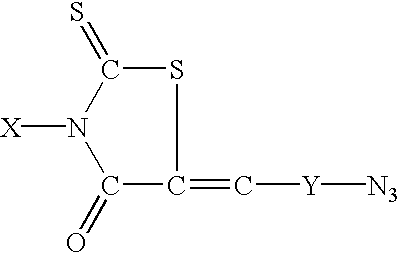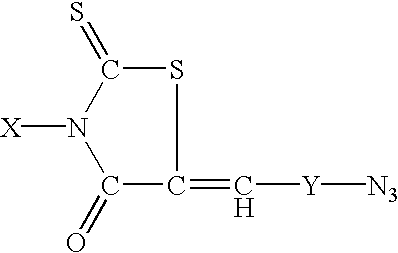Imageable photoresist laminate
a photoresist laminate and photoresist technology, applied in the field of photoresist laminates, can solve the problems of difficult positioning of diazonium compositions, lack of adequate strength and durability of styrylpyridinium compositions for some applications, and insufficient storage stability of diazonium salts, etc., to achieve the effect of improving processability, surface modification, and photoimaging
- Summary
- Abstract
- Description
- Claims
- Application Information
AI Technical Summary
Benefits of technology
Problems solved by technology
Method used
Image
Examples
examples
[0041] The following specific examples are used to further illustrate the invention. These examples are merely illustrative of the invention and do not limit its scope. The mixtures were made by weighing each of the ingredients into a mixing vat. The ingredients were mixed using an overhead mixing system with a standard propeller. The resulting mixtures exhibited good film-forming and adhesive properties and were photoimageable.
3 Ingredient Solution Dry Film (and approx. solids %) Identifier and Source WT % WT % Example 1 -Coating Emulsion Contents photosensitive resin RTP-1001 from Toyo Gosei Kogyo, 20 6.30 (13% solids) Ltd., Chiba, Japan). polyvinyl alcohol PVA 540 from AirProducts 15.3 4.68 (12-13% solids) surfactant Fluorad FC-170C from 3M Company of 0.12 0.27 St. Paul, Minnesota pigment Unisperse Red RBS-PI from Ciba-0.22 0.22 Geigy isopropanol -- 1.67 --polyvinyl acetate PN-3178Z from HB Fuller 40.71 54.29 (52 to 56% solids) polyvinyl acetate XR-2223 from HB Fuller 8.74 11.66 ...
PUM
| Property | Measurement | Unit |
|---|---|---|
| thickness | aaaaa | aaaaa |
| thick | aaaaa | aaaaa |
| thick | aaaaa | aaaaa |
Abstract
Description
Claims
Application Information
 Login to View More
Login to View More - R&D
- Intellectual Property
- Life Sciences
- Materials
- Tech Scout
- Unparalleled Data Quality
- Higher Quality Content
- 60% Fewer Hallucinations
Browse by: Latest US Patents, China's latest patents, Technical Efficacy Thesaurus, Application Domain, Technology Topic, Popular Technical Reports.
© 2025 PatSnap. All rights reserved.Legal|Privacy policy|Modern Slavery Act Transparency Statement|Sitemap|About US| Contact US: help@patsnap.com



